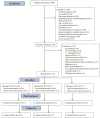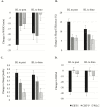Cognitive behavioral treatments for insomnia and pain in adults with comorbid chronic insomnia and fibromyalgia: clinical outcomes from the SPIN randomized controlled trial
- PMID: 30496533
- PMCID: PMC6424087
- DOI: 10.1093/sleep/zsy234
Cognitive behavioral treatments for insomnia and pain in adults with comorbid chronic insomnia and fibromyalgia: clinical outcomes from the SPIN randomized controlled trial
Abstract
Study objectives: To examine the effects of cognitive behavioral treatments for insomnia (CBT-I) and pain (CBT-P) in patients with comorbid fibromyalgia and insomnia.
Methods: One hundred thirteen patients (Mage = 53, SD = 10.9) were randomized to eight sessions of CBT-I (n = 39), CBT-P (n = 37), or a waitlist control (WLC, n = 37). Primary (self-reported sleep onset latency [SOL], wake after sleep onset [WASO], sleep efficiency [SE], sleep quality [SQ], and pain ratings) and secondary outcomes (dysfunctional beliefs and attitudes about sleep [DBAS]; actigraphy and polysomnography SOL, WASO, and SE; McGill Pain Questionnaire; Pain Disability Index; depression; and anxiety) were examined at posttreatment and 6 months.
Results: Mixed effects analyses revealed that both treatments improved self-reported WASO, SE, and SQ relative to control at posttreatment and follow-up, with generally larger effect sizes for CBT-I. DBAS improved in CBT-I only. Pain and mood improvements did not differ by group. Clinical significance analyses revealed the proportion of participants no longer reporting difficulties initiating and maintaining sleep was higher for CBT-I posttreatment and for both treatments at 6 months relative to control. Few participants achieved >50% pain reductions. Proportion achieving pain reductions of >30% (~1/3) was higher for both treatments posttreatment and for CBT-I at 6 months relative to control.
Conclusions: CBT-I and CBT-P improved self-reported insomnia symptoms. CBT-I prompted improvements of larger magnitude that were maintained. Neither treatment improved pain or mood. However, both prompted clinically meaningful, immediate pain reductions in one third of patients. Improvements persisted for CBT-I, suggesting that CBT-I may provide better long-term pain reduction than CBT-P. Research identifying which patients benefit and mechanisms driving intervention effects is needed.
Clinical trial: Sleep and Pain Interventions in Fibromyalgia (SPIN), clinicaltrials.gov, NCT02001077.
Keywords: CBT; cognitive behavioral treatments; comorbid chronic insomnia; fibromyalgia; pain; sleep.
© Sleep Research Society 2018. Published by Oxford University Press [on behalf of the Sleep Research Society]. All rights reserved. For permissions, please email: journals.permissions@oup.com.
Figures




References
-
- Theadom A, et al. . Exploring the role of sleep and coping in quality of life in fibromyalgia. J Psychosom Res. 2007;62(2):145–151. - PubMed
-
- White KP, et al. . The London Fibromyalgia Epidemiology study: comparing the demographic and clinical characteristics in 100 random community cases of fibromyalgia versus controls. J Rheumatol. 1999;26(7):1577–1585. - PubMed

